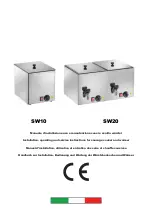
61
Tested for you in our cooking studio
Here you will find a selection of dishes and the ideal settings for
them. We will show you which type of heating and which
temperature are best suited for your dish. You can find
information about suitable accessories and the height at which
they should be inserted. There are also tips about cookware and
preparation methods.
Notes
■
The values in the table always apply to dishes placed into the
cooking compartment when it is cold and empty.
Only preheat the appliance if the table specifies that you should
do so. Do not line the accessories with greaseproof paper until
after they have been preheated.
■
The times specified in the tables are guidelines only. They will
depend on the quality and composition of the food.
■
Use the accessories supplied. Additional accessories may be
obtained as special accessories from specialist retailers or from
the after-sales service.
Before using the oven, remove any unnecessary accessories
and ovenware from the cooking compartment.
■
Always use oven gloves when taking hot accessories or
ovenware out of the cooking compartment.
Cakes and pastries
Baking tins
It is best to use dark-coloured metal baking tins.
Baking times are increased when light-coloured baking tins made
of thin metal or glass dishes are used, and cakes do not brown so
evenly.
If you wish to use silicone baking tins, use the information and
recipes provided by the manufacturer as a guide. Silicone baking
tins are often smaller than normal tins. The amount of mixture and
recipe instructions may differ.
Tables
The tables show the ideal type of heating for the various cakes
and pastries. The temperature and baking time depend on the
amount and composition of the mixture. This is why temperature
ranges are given in the tables. You should try the lower
temperature first, since a lower temperature results in more even
browning. You can increase the temperature next time if
necessary.
If you preheat the oven, the baking time is shortened by 5 to 10
minutes.
Additional information can be found in the
Baking tips
section
following the tables.
Cake in a mould
Tin
Level
Type of heat
-
ing
Temperature in
°C
Cooking time in
minutes
Cakes*
Round springform cake tin
with tube sheet, deep
3
<
160-180
60-70
Sponge cake
Springform cake tin
(dia. 26 cm)
3
<
160-180
35-45
Shortcrust pastry
Cake tin with non-stick
coating, round (dia. 30 cm)
3
<
150-170
25-35
Fruit flan*
Springform cake tin
(dia. 26 cm)
3
<
160-180
45-55
Brownies*
Glass ovenproof dish, rec
-
tangular**
3
<
170-190
35-45
Semolina cake*
Stainless steel ovenproof
dish, round (dia. 30 cm)
3
<
160-180
30-40
Quiche*
Ovenproof dish with non-
stick coating, round
(dia. 30 cm)
3
<
180-200
50-60
* Insert the wire rack at the level indicated and place the cake tin in the centre of the wire rack.
** Only use heat-resistant glass dishes. Do not place a hot glass dish on a cold or wet surface. The glass could break.
Several small baked items on the baking
sheet
Accessories
Level
Type of heat
-
ing
Temperature in
°C
Cooking time in
minutes
Small cakes, preheat*
Baking sheet
3
<
150-170
25-35
2 baking trays
1+3
<
150-170
25-35
3 baking trays
1+3+5
<
140-160
30-40
Sponge
Baking sheet
3
<
150-170
10-20
2 baking trays
1+3
<
130-150
25-35
3 baking trays
1+3+5
<
130-150
25-35
Biscuits
Baking sheet
3
<
140-160
20-30
2 baking trays
1+3
<
160-180
35-45
3 baking trays
1+3+5
<
160-180
35-45
* Do not use rapid heating to preheat the appliance.
Additional baking trays can be ordered from the after-sales service.








































